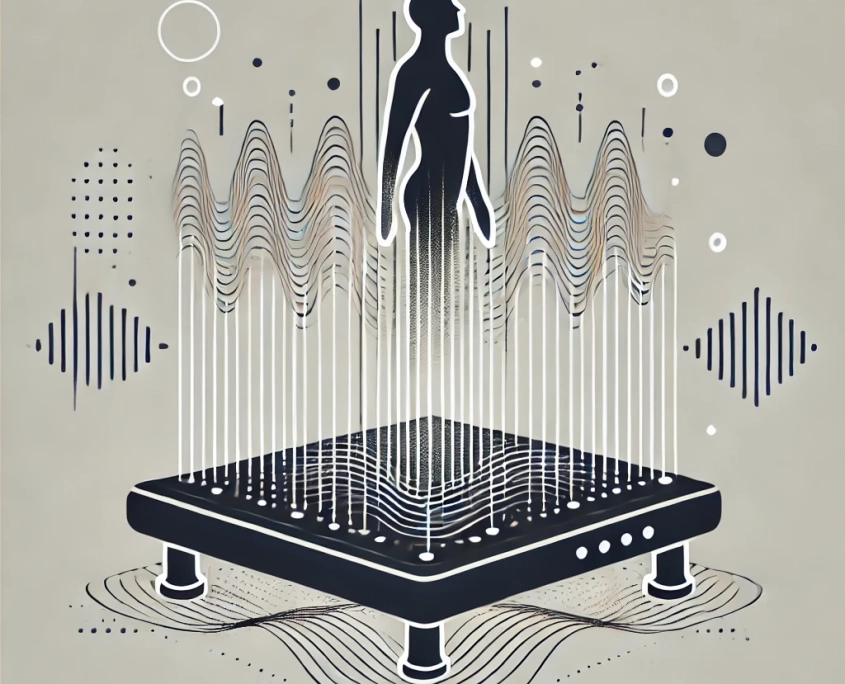The Therapeutic Benefits of Whole-Body Vibration Therapy: Enhancing Proprioception and Pain Reduction

Abstract:
Whole-body vibration (WBV) therapy is an innovative approach that utilizes harmonic vibrations to stimulate the body’s muscular, nervous, and circulatory systems. The Power Plate pro5 AIRdaptive is a high-end WBV platform known for its adaptive air suspension system, designed to accommodate users of varying weights and fitness levels. This paper explores the therapeutic benefits of WBV therapy, focusing on its impact on proprioception and pain reduction.
Introduction:
Whole-body vibration (WBV) therapy has emerged as a versatile and effective modality in the realms of fitness, rehabilitation, and overall wellness. This paper investigates the therapeutic benefits of WBV therapy, specifically using the Power Plate pro5 AIRdaptive platform, which features an adaptive air suspension system to cater to diverse user needs. The focus is on how WBV therapy enhances proprioception and aids in pain reduction, providing a multifaceted approach to health improvement.
Why Use WBV Therapy?
WBV therapy offers numerous health benefits, making it a valuable tool for patients seeking comprehensive wellness solutions. Key benefits include:
Muscle Strengthening: WBV induces rapid muscle contractions, which enhance muscle strength and tone.
Balance and Coordination: Vibrations from the platform stimulate proprioceptors, improving balance and coordination through enhanced proprioceptive feedback mechanisms.
Flexibility: The therapy promotes muscle relaxation and increased blood flow, which enhances overall flexibility.
Circulation: WBV increases blood flow, aiding in recovery and enhancing overall wellness.
Bone Density: It stimulates osteoblast activity, potentially improving bone density and reducing the risk of osteoporosis.
Rehabilitation: WBV is used in physical therapy to aid in the rehabilitation of injuries and recovery from surgeries.
Proprioception and WBV Therapy:
Proprioception is the body’s ability to sense its position, movement, and equilibrium, facilitated by specialized sensory receptors known as proprioceptors, which are located in muscles, tendons, and joints. WBV therapy enhances proprioception through several mechanisms:
Vibration Stimulus: The platform generates vibrations that travel through the body, stimulating muscle spindles and Golgi tendon organs (proprioceptors).
Reflexive Contractions: The rapid vibrations cause reflexive muscle contractions, enhancing proprioceptive feedback as muscles continually adjust to maintain balance.
Increased Neural Activity: Stimulation of proprioceptors increases neural activity in sensory pathways, enhancing proprioceptive awareness and coordination.
Pain Reduction Mechanisms:
While stimulating receptors to reduce pain might seem contradictory, WBV therapy employs several mechanisms to achieve pain relief:
Gate Control Theory of Pain: Non-painful input from WBV can close the “gates” to painful input, preventing pain signals from traveling to the central nervous system, effectively “drowning out” pain signals.
Enhanced Blood Flow: Increased circulation helps reduce inflammation and accelerates the healing process, thereby reducing pain.
Endorphin Release: Mechanical stimulation from WBV can lead to the release of endorphins, the body’s natural painkillers, which reduce pain perception.
Muscle Relaxation: Rapid muscle contractions and relaxations lead to overall muscle relaxation, reducing muscle tension and associated pain.
Conclusion:
The Power Plate pro5 AIRdaptive WBV machine offers a comprehensive approach to enhancing patient health through its ability to strengthen muscles, improve balance and coordination, increase flexibility, boost circulation, and support bone health. Additionally, WBV therapy’s ability to enhance proprioception and reduce pain through various physiological mechanisms makes it a valuable tool in both fitness and rehabilitation settings. By incorporating WBV therapy, practitioners can offer patients a non-invasive, effective method to improve their overall well-being and manage pain.
References:
- Rittweger, J. (2010). Vibration as an exercise modality: how it may work, and what its potential might be. European Journal of Applied Physiology, 108(5), 877-904.
- Lau, R. W., & Liao, L. R. (2011). Effects of whole-body vibration therapy on body functions and structures, activity, and participation poststroke: a systematic review. Physical Therapy, 91(1), 123-136.
- Gusi, N., Raimundo, A., & Leal, A. (2006). Low-frequency vibratory exercise reduces the risk of bone fracture more than walking: a randomized controlled trial. BMC Musculoskeletal Disorders, 7(1), 92.
- Rogan, S., Hilfiker, R., Herren, K., Radlinger, L., & de Bruin, E. D. (2011). Effects of whole-body vibration on postural control in elderly: a systematic review and meta-analysis. BMC Geriatrics, 11(1), 72.
- Cardinale, M., & Bosco, C. (2003). The use of vibration as an exercise intervention. Exercise and Sport Sciences Reviews, 31(1), 3-7.
- Cochrane, D. J. (2011). Vibration exercise: the potential benefits. International Journal of Sports Medicine, 32(02), 75-99.
